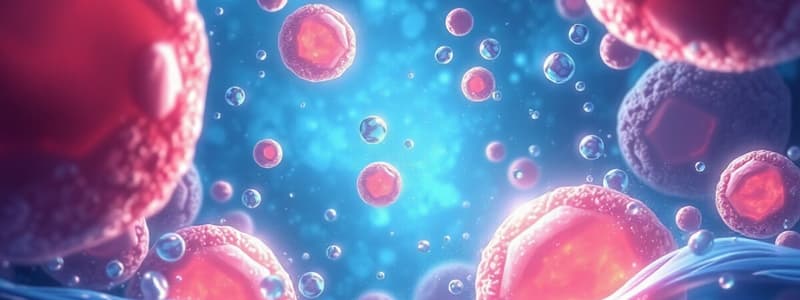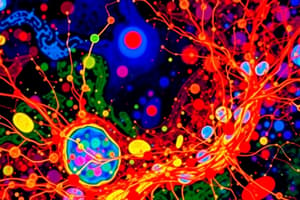Podcast
Questions and Answers
Match the ion with its behavior in an aqueous solution:
Match the ion with its behavior in an aqueous solution:
Sodium ion ($Na^+$) = Attracted to the partially negative oxygen of water. Chloride ion ($Cl^-$) = Attracted to the partially positive hydrogen of water. Polar molecule = Interacts with water molecules through hydrogen bonds. Nonpolar molecule = Exhibits minimal interaction with water.
Match the term with its correct description regarding water's properties:
Match the term with its correct description regarding water's properties:
Polarity = Unequal sharing of electrons, leading to partial charges. Hydrogen bond = An attraction between a slightly positive hydrogen and a slightly negative atom. Hydrophilic = Substances that dissolve or interact readily with water. Hydrophobic = Substances that do not dissolve or interact readily with water.
Match the cellular process with the effect of ion concentration changes:
Match the cellular process with the effect of ion concentration changes:
Egg cell activation = Cytosol electronegativity changes from negative to positive due to decreased chloride ions. Maintaining cell volume = Regulated by ion channels to control water movement. Nerve impulse transmission = Dependent on sodium and potassium ion gradients. Muscle contraction = Triggered by calcium ion release.
Relate the term with the effect on ionic compounds when in a aqueous solution:
Relate the term with the effect on ionic compounds when in a aqueous solution:
Match the following scenarios with the most relevant property of water:
Match the following scenarios with the most relevant property of water:
Match the following scenarios with the property of water that best explains it:
Match the following scenarios with the property of water that best explains it:
Match the following definitions with the correct term related to water's properties:
Match the following definitions with the correct term related to water's properties:
Relate the following phenomena to the property of water that primarily contributes to it:
Relate the following phenomena to the property of water that primarily contributes to it:
Match the following examples with the underlying property of water that explains the scenario:
Match the following examples with the underlying property of water that explains the scenario:
Match the following descriptive features to the properties of water:
Match the following descriptive features to the properties of water:
Match the following cell components with their primary water content:
Match the following cell components with their primary water content:
Match the roles of water with its importance in living organisms:
Match the roles of water with its importance in living organisms:
Match the following percentages to their corresponding biological context regarding water:
Match the following percentages to their corresponding biological context regarding water:
Match the following properties of water with their chemical basis:
Match the following properties of water with their chemical basis:
Match each trait with the structural aspect of water that causes it:
Match each trait with the structural aspect of water that causes it:
Match each body part with its relative water percentage
Match each body part with its relative water percentage
Match each characteristic to its description
Match each characteristic to its description
Match each term to its definition
Match each term to its definition
Match each state of water with its description at the molecular level:
Match each state of water with its description at the molecular level:
Match the following properties of water with their related biological significance:
Match the following properties of water with their related biological significance:
Match each application with the property of water that makes it suitable for that application:
Match each application with the property of water that makes it suitable for that application:
Match the consequence with the property of water that leads to it:
Match the consequence with the property of water that leads to it:
Match each scenario with the property of water that is primarily responsible:
Match each scenario with the property of water that is primarily responsible:
Match the following term to its definition:
Match the following term to its definition:
Match the examples below to the property of water they exemplify:
Match the examples below to the property of water they exemplify:
Associate the following scenarios with the property of water that explains them:
Associate the following scenarios with the property of water that explains them:
Flashcards
Water's Polarity
Water's Polarity
Uneven distribution of electron density creating partial charges.
Hydrogen Bonds in Water
Hydrogen Bonds in Water
Attraction between water molecules due to their polarity.
Hydrophilic
Hydrophilic
Substances that dissolve or are attracted to water.
NaCl and Water Attraction
NaCl and Water Attraction
Signup and view all the flashcards
NaCl in Cytosol
NaCl in Cytosol
Signup and view all the flashcards
Cytosol
Cytosol
Signup and view all the flashcards
Blood Plasma
Blood Plasma
Signup and view all the flashcards
Water Percentage in Living Things
Water Percentage in Living Things
Signup and view all the flashcards
Origin of Life & Water
Origin of Life & Water
Signup and view all the flashcards
Hydrothermal Vent
Hydrothermal Vent
Signup and view all the flashcards
Organ With Highest % Water
Organ With Highest % Water
Signup and view all the flashcards
Water Chemical Formula
Water Chemical Formula
Signup and view all the flashcards
Bonds Between H and O in Water
Bonds Between H and O in Water
Signup and view all the flashcards
Water's Three States
Water's Three States
Signup and view all the flashcards
Liquid Water Dynamics
Liquid Water Dynamics
Signup and view all the flashcards
Gaseous Water
Gaseous Water
Signup and view all the flashcards
Solid Water Structure
Solid Water Structure
Signup and view all the flashcards
Ice Crystal Damage
Ice Crystal Damage
Signup and view all the flashcards
Water's High Heat Capacity
Water's High Heat Capacity
Signup and view all the flashcards
Water's Specific Heat
Water's Specific Heat
Signup and view all the flashcards
Water in Blood Plasma
Water in Blood Plasma
Signup and view all the flashcards
Water as a Solvent
Water as a Solvent
Signup and view all the flashcards
Sphere of Hydration
Sphere of Hydration
Signup and view all the flashcards
Cohesion
Cohesion
Signup and view all the flashcards
Surface Tension
Surface Tension
Signup and view all the flashcards
Adhesion
Adhesion
Signup and view all the flashcards
Study Notes
Water in the Cells
- All living things are made of one or more cells.
- All cells contain cytoplasm.
- Cytoplasm is comprised of cytosol (a gel-like substance), organelles (e.g., mitochondrion), macromolecules, and ions.
- Cytosol is about 70-80% water and usually colorless.
- Cellular metabolism occurs within the watery content of the cytosol.
- Water is essential for cellular processes like photosynthesis.
Water Around the Cells
- Tissue: a group of cells with similar functions.
- Connective tissue: cellular + non-cellular components.
- Blood: connective tissue comprised of 45% red/white blood cells and 55% blood plasma.
- Blood plasma is 92% water.
Water in Living Things
- Water accounts for 60-70% of the human body.
- Water composes approximately 60-95% of different living things.
- Water is essential for life.
- Brain tissue is 75% water.
- Blood is 83% water.
- The heart is 79% water.
- Bones are 22% water.
- Muscles are 75% water.
- The liver is 86% water.
- The kidneys are 83% water.
Beginning of Life
- Life initially evolved in a marine environment.
- First macromolecules, then organelles, culminated in cells.
- Hydrothermal vents on the deep ocean floor provide abundant water and nutrients in the absence of light.
Water's Polarity
- Hydrogen and oxygen form covalent bonds within a water molecule.
- Hydrogen has a slightly positive charge (H+), while oxygen has a slightly negative charge (O-).
- Each water molecule attracts other water molecules, forming hydrogen bonds due to its polarity, contributing to water's properties of attraction.
- Water attracts or is attracted to other polar molecules and ions.
- Substances that interact with or dissolve in water are hydrophilic (hydro=water, -philic=loving)
Sodium Chloride + Water = Ions + Water
- Salt is made up of sodium chloride (NaCl).
- The positive part of water molecules (hydrogen+) attracts negative chloride ions (Cl-).
- The negative part of water molecules (oxygen-) attracts positive sodium ions (Na+).
Ions Dissolved in Water: Ions Dissolved in the Cytosol
- Ions are important for cell processes, particularly in cellular processes.
- A decrease of chloride ions (Cl-) in the egg's cytosol changes the electronegativity from negative to positive.
Water's States: Gas, Liquid, and Solid
- Liquid water: hydrogen bonds constantly form and break as water molecules slide past each other.
- Gas water: when water boils, the higher energy causes hydrogen bonds to break, releasing water molecules into the air as steam or vapor.
- Solid water: when water temperature reduces, water molecules form a crystal structure via hydrogen bonding.
- Solid water is less dense than liquid water due to hydrogen bonds orienting as the water freezes and pushes the molecules farther apart.
- Ice floats at the surface of liquid water.
- Upon freezing, ice crystals rupture the delicate cell membrane and proteins required for living cells to function
- Adding a solution like glycerol, binds with water’s hydrogen bonds, to make it difficult to crystalize until -37.8C.
Water's High Heat Capacity
- Water's high heat capacity results from hydrogen bonding among water molecules.
- Water has the highest specific heat capacity of any liquid.
- Water is super strong when it comes to heat: A small amount of water can hold a lot of heat without its temperature rising.
- It takes water a long time to heat and a long time to cool.
- Blood plasma is mostly water: this is a great way to disperse and save heat in the body
- Fever is a result of the body's heat capacity.
- The induction of fever in endothermic animals occurs at a high metabolic cost such that a 1°C rise in body temperature requires a 10–12.5% increase in metabolic rate.
Water's Solvent Properties
- Water, a polar molecule with slightly positive and negative charges, can readily dissolve ions and polar molecules, making it a great solvent.
- Ions and polar molecules form hydrogen bonds with water, surrounding the particle with water molecules (sphere of hydration)
- Table salt (NaCl) + water = Na+ + Cl- + water.
Water's Cohesive and Adhesive Properties
- Cohesion allows for surface tension.
- Surface tension is the capacity of a substance to withstand rupturing when placed under tension or stress.
- Water molecules are attracted to each other because of hydrogen bonding.
- A water strider can float on surface water due to its cohesive properties.
- Attraction can be stronger than water's cohesive forces, especially where water is exposed to charged surfaces such as capillary tubes.
- Water “climbs” up the capillary tube.
- Capillary action: water appears higher on the tube's sides than in the middle because water molecules are more attracted to the capillary's charged glass walls than to each other.
- Adhesive forces create a “pull" on the water column.
- Pull results from the tendency of water molecules evaporating on the plant's surface to stay connected to the water molecules below them.
Studying That Suits You
Use AI to generate personalized quizzes and flashcards to suit your learning preferences.




